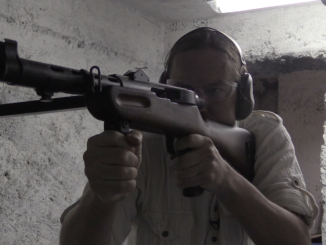Steyr introduced their TMP (Tactical Machine Pistol) and its semiauto SPP counterpart in 1989, but it was never a very popular item. After the company was purchased, the new ownership decided to scrap the TMP (along with other low-performing product lines). At that point, Swiss firm B&T purchased the whole project for a nominal one Austrian Schilling and began to develop it themselves. B&T made a number of reliability improvements to the basic design, and perhaps most importantly added a folding stock to what had previously been a machine pistol design. They now offer it as a semiauto civilian pistol or carbine, and as a PDW or submachine gun to military clients. It has been adopted by a number of units around the world in a variety of roles including pilot survival weapon, maritime boarding party armament, and compact special forces SMG.
Related Articles

Light MGs
Swiss Week – LMG25 video
This week, we will be featuring all Swiss weapons here at Forgotten Weapons. Kind of like Shark Week, but more land-locked. We’ll kick off today with a video showing you around a Swiss LMG-25 light […]

Submachine Guns
Feeling the Bern: Shooting the Swiss Furrer MP-41/44 SMG
When I filmed yesterday’s video on the MP-41/44, and did not know I would have a chance to actually do some live fire with it. But we snuck off to a little shooting range to […]

Book review
Book Review: Automatwaffen II
It’s a bit of a different book review today – since we’ve been looking at Swiss arms all week (and there’s a really unique one coming up tomorrow), we needed to find a book on […]

STEYR-DAIMLER-PUCH also ‘messed up’ the STEYR GB (Pi-18), which was already fully developed at the beginning of the 1970s and would have hit the market like a bomb at the time due to its performance data… Due to the extremely strange management at the time, the market launch was delayed until 1882 and the ‘Rogak P-18’ plagiarism of subterranean quality – also caused by mismanagement – ruined the reputation of the STEYR GB.
If you fancy reading (unfortunately only in German) my WIKI article: https://de.wikipedia.org/wiki/Steyr_GB . It was written in collaboration with Hannes Kepplinger, the former designer of the GB.
It seems to me that the MP9 and TP9 flopped for the same reasons as the GB…
Ian: Perhaps you could also make a video about the GB?
Ian’s put up GB info, before…
https://www.forgottenweapons.com/other-handguns/steyr-gb/
You rather get the impression that Steyr wasn’t really interested in selling anything other than hunting rifles to civilians… Anything other than that, they wanted to be selling to governments. Which probably the “why” answer for a lot of your questions, and I’d wager that much of it stemmed from Austria’s neutrality and government interventions to maintain that neutrality.
What motivated Steyr to sell the technical package plus a load of TMP parts for one Schilling?
Good friends maybe?
In my accounting classes we learned about a managerial convention known as good will.
http://modernfirearms.net/en/submachine-guns/switzerland-submachine-guns/bt-mp-9-eng/ does offer certain hint stating that The famous Steyr-Mannlicher company developed it in Austria, but Austrian export licensing laws, lack of a sales and resulted in the decision of Steyr to drop the TMP from the product line in 2001.
Therefore it seems that mentioned export licensing laws would detract much of income for Steyr-Mannlicher, though further research is required to unveil why these laws hit said sub-machine gun with such force.
Seems like for Steyr it was kind of superfluous what with the MPi 69/81, although I think production halted in the early 1990s? At least the TMP had closed-bolt/ more accuracy albeit hindered by heavy trigger pull…I think the federal police/ post-gendarmerie in Oesterreich have long used the MP5.
Perhaps with the AUG 9mm, and the ongoing concerns about the 9mm’s “inadequacy” vis-a-vis body armor and so on the 5.7mm P90 and German MP7 have undercut any R&D for a 9mm SMG/ machine pistol/ service pistol?
0:53 Erm, Steyr SPP as selective and the TMP as semi-only? Hmm, somehow I remember it the other way around, as Taktische Maschinenpistole feat. The Fun Switch, and Special Purpose Pistol civilian-legal semiauto-only knock-off. And even the text accompanying the video has it the right way.
5:20 this three-position transverse switch is typically Steyr – they used it on the MPi-69 and in AUG as well. Another gun featuring it was the Franchi LF57 in their Portuguese incarnation
30:00 The Polish special force that ordered it was the BOR, Gov’t Protection Service, protecting the government VIPs, BTW probably the first user of the Glock 17s behind the then still Iron Curtain (ordered ca. 1986, three years before Curtain fell)
“never were very popular”
Well, considering that vertical foregrip on the semi-auto pistol version SILL makes it an NFA item, I can see why